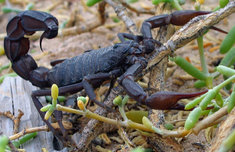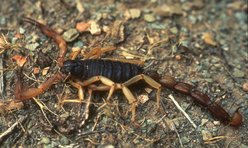Physical characteristics
The scorpion body is divided into 2 main segments: the cephalothorax and the abdomen. The cephalothorax consists of the prosoma, and the abdomen of the mesosoma and the metasoma;
Prosoma: the “head” of the scorpion comprising the carapace, eyes, chelicerae (mouth parts) and pedipalps (claw).
Mesosoma: The main body of the scorpion contains its lungs, digestive tract and sexual organs. The 4 pairs of walking legs (a common feature of the arachnids) are attached to this section, as are the pectines (featherlike sensory organs). The mesosoma is armoured with chitinous plates, on the upper surface by the tergites and on the lower surface by the sternites.
Metasoma: The tail of the scorpion comprising 5 segments, the last containing the anus of the scorpion and bearing the telson (the sting). The telson, in turn, consists of the vesicle, which holds a pair of venom (poison) glands, and the hypodermic aculeus, the barb used to inject the venom.
Main Scorpion Physical Features:
Pedipalps: The claws, some believe these were originally modified legs that evolved into claws. The claws are used primarily for prey capture, but also play an important part in the scorpion mating dance. The pedipalps are made of up of 6 segments. The claw itself consists of the upper fixed finger (tibia) and the lower movable finger (tarsus). The size of the pedipalps is highly dependent on the species; however a general trend is that the more venomous the scorpion, the narrower the pedipalps, as scorpions with less potent venom use their larger pincers to subdue prey.
Pectines: These are a pair of feather-like sensory organs, consisting of a row of pegs, and are unique in scorpions. The pectines are located beneath the scorpion, attached to the sternum. They constantly touch the ground and play an important role in the scorpion's sensory equipment. The pectines are covered in thousands of chemosensors that allow the scorpion to detect minute chemical signals in their environment; they probably play an important role in social interaction, mating and hunting.
Eyes: Scorpions in general have three sets of eyes. One pair located in the top centre of the carapace are called the median eyes. There are two more sets of lateral eyes on either side of the front of prosoma, the number varies between species. Some species of cave- and litter-dwelling scorpions, however, have no eyes, relying purely on their other senses. Scorpions' eyes are primitive organs, only able to detect regions of strongly contrasting light intensity, such as horizons. The eyes are however very sensitive: some have theorised that they even allow the scorpion to navigate by star light, and they are important in regulating the scorpion's circadian rhythm. It is doubtful as to whether they are used in prey capture.
Scorpion venom
All species of scorpion possess venom. In general scorpion venom is described as neurotoxic in nature. It consists of a variety of small proteins as well as sodium and potassium cations, which serve to interfere with neurotransmission in the victim. Scorpions use their venom to kill or paralyze their prey so that it can be eaten; in general it is fast acting, allowing for effective prey capture.
Scorpion venoms are geared towards activity in other arthropods and therefore most scorpions are relatively harmless to humans; stings produce only local effects (such as pain, numbness or swelling). However a few scorpions, mostly in the family Buthidae, can be dangerous to humans. Among the most dangerous are Leiurus quinquestriatus, which has the most potent venom in the family, and members of genus Parabuthus, Tityus and Androctonus whose venom is also strong. These scorpions and others in the family Buthidae have been responsible for many deaths, although scorpions are generally unable to deliver enough venom to kill healthy adults; deaths normally occur in the young, elderly or infirm. Unless molested, scorpions are generally harmless and timid, and only make use of the sting for the purpose of killing prey. Generally, they will run from danger, or remain very still. It is unknown whether scorpions are venom conservers, however often the venom is not used unless the prey cannot be subdued with the claws. Many species of scorpions such as Pandinus and Hadogenes rarely, if ever, use their venom, instead relying on their strong bulky pedipalps in prey capture.
Reproduction
Scorpions generally reproduce sexually and all species have male and female individuals. Reproduction is accomplished by the transfer of a spermatophore from the male to the female; scorpions have evolved a complex courtship and mating ritual to affect this transfer.
Mating starts by the male and female locating and identifying each other using a mixture of pheromones and vibronic communication, once they have satisfied each other that they are of opposite sex and of the correct species mating can commence.
The courtship starts with the male grasping the female’s pedipalps with his own; the pair then performs a “dance” called the “promenade à deux”. In reality this is the male leading the female around searching for a suitable place to deposit his spermatophore. The courtship ritual can involve several other behaviours such as juddering and a cheliceral kiss, probably as a meanings of pacifying the female.
When he has identified a suitable location he guides the female over the spermatophore allowing it to enter her genital opercula, this triggers release of the sperm; fertilising the female. The mating process can take from 1 to 25+ hours and depends on the ability of the male to find a suitable place to deposit his spermatophore, if mating goes on for too long females may eventually break off the process.
Once the mating is complete the male and female quickly separate: the male will generally retreat quickly to avoid being cannibalised by the female, although sexual cannibalism is infrequent with scorpions.
Read more at Wikipedia.org


